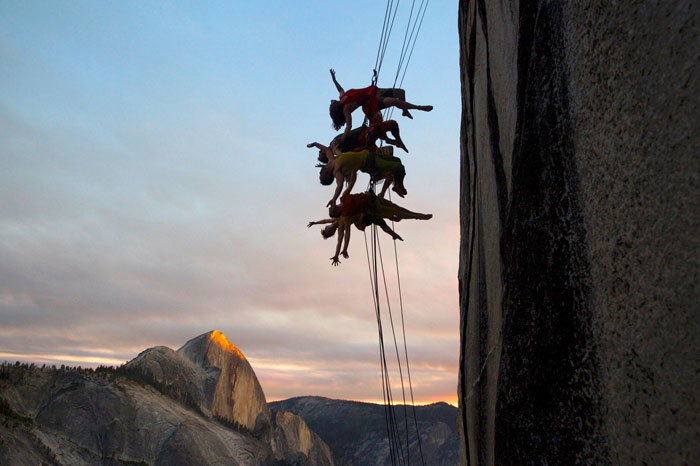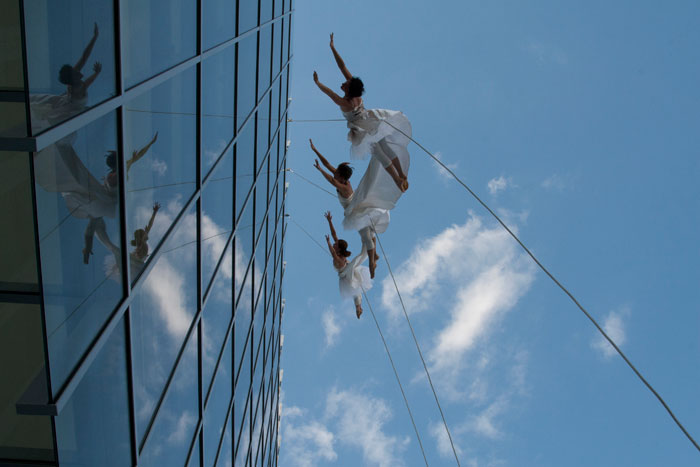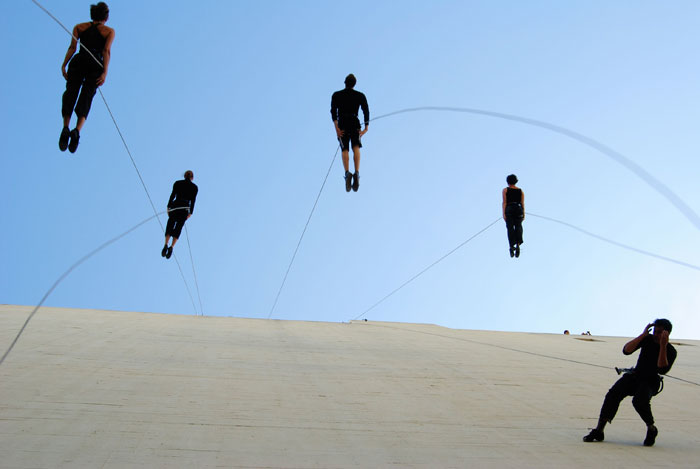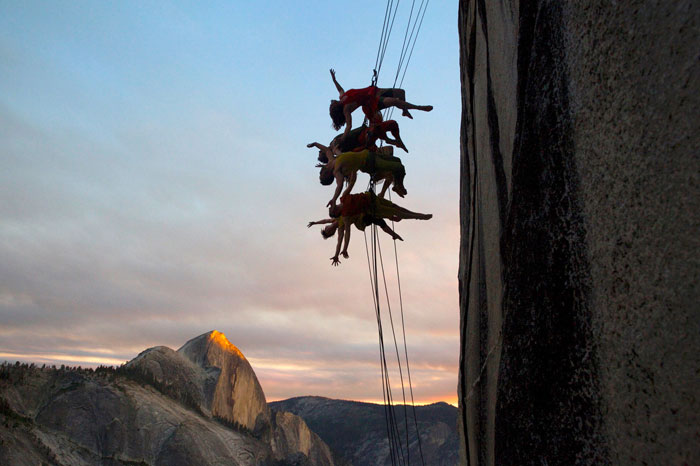- Yosemite E-Biking - 01/12/2023
- The Yosemite Climbing Association - 09/01/2022
- Ryan Sheridan & Priscilla Mewborne - 05/17/2022
Now in its twenty-sixth year, BANDALOOP performers turn cliffs and buildings into dance floors, bringing experimental art to audiences throughout the world
By Chris Van Leuven

Bandaloop dancers at sunrise on Mt. Watkins in Yosemite (Basil Tsimoyanis).
Yosemite High Country, 2015, Sunrise: Surrounded by sharp peaks, the sun’s first rays peeking through the horizon, Amelia Rudolph twists her arms and legs and arches her back on a rocky overlook, dancing alone surrounded in nature’s beauty. Next scene: A woman is clipped to a white rope strung up a ponderosa pine, with her bare feet outstretched in front, body parallel to the ground, using the trunk as a dance surface.
A few days earlier, climbing hardware and hundreds of feet of static ropes are unpacked from haulbags as the BANDALOOP crew prepares to rig lines partway down Mount Watkins, a 2,000-foot wall overlooking Half Dome, for the dancers to perform on. Harnesses and rigging are triple checked. Approaching the “stage,” a lone figure walks down the vertical wall.
Associate artistic director and dancer Melecio Estrella describes the feeling of being on the line as “a state of play with gravity and momentum – during a jump we’ll leave the wall for up to ten seconds.”
Though the choreography looks effortless, this comes from months and years of practice. This is evident in the soft landings of their bare feet making contact with the rock and uninterrupted lines crossing over the dancers as they come together and break apart. Dancing with bare feet allows the bones in their feet and ankles to divvy the impact without damaging the surface of glass planes and the walls of historic buildings.
Executive Director Thomas Cavanagh says that the project brings dance to the people, often in the most unexpected of places, including buildings, public spaces, convention halls, historic sites, theaters and cliff edges. “There is an interruption of someone’s day, an incidental audience – if people can dance on the side of a building, what can’t be done?”
Head rigger Braden Mayfield, son of longtime dancer and rigger Peter Mayfield, says, “It takes the audience awhile before their perspective is tilted. Then it looks fun and beautiful. It’s so surreal to people that it catches their attention.” Braden is one of six head riggers.
Though BANDALOOP rents a high-ceiling studio in Oakland, they also rehearse on The Great Wall of Oakland positioned at the intersection of Grand and Broadway surrounded by locally owned workspaces and restaurants.
Since its inception in 1991, BANDALOOP has performed in 22 countries and to millions of people both live and via the web or TV. Shows range from five to 90 minutes, played out in epic natural settings such as Yosemite, the Italian Dolomites, the Indian Himalaya and the rural mountains of China. Urban locations include the Space Needle in Seattle, Oakland City Hall, Los Angeles City Hall, and the John F. Kennedy Center for the Performing Arts in Washington, DC.
The group is featured in an upcoming IMAX film on art and music in America. They also recently performed in an Arctic Circle Arts Festival in northern Norway, on a decommissioned crane in front of 3,000 people dressed in puffy down jackets to keep warm against the ten-degree temps.
Performances are noted in The New York Times, Life Magazine, NPR, CNN and Smithsonian Magazine.

Tianmen Mountain in rural China (James Adamson).
Humble Beginnings
BANDALOOP founder Amelia Rudolph (currently on sabbatical in Italy), was born in Chicago and studied dance since childhood, spending every fourth year in India from her early years through her teens. Her late parents who were noted University of Chicago scholars were based in India and South Asia. An early student of Chicago Hubbard Street dance academy, Rudolph holds Bachelor’s and Master’s degrees in comparative religion from Swarthmore College and the Graduate Theological Union, Berkeley. In 1990, now residing in Oakland, Rudolph – capitalizing on an explosion of modern dance in the Bay Area and the opening of CityRock in Emeryville – founded BANDALOOP.
Rudolph didn’t just see the gym or the crag as a space for climbers, she saw it as a connection to vertical art. “Amelia had the vision to re-interpret and site react on locations through the vehicle of dance,” Cavanagh says. Rudolph connected with CityRock founder Peter Mayfield and began climbing and began making regular pilgrimages to Yosemite to explore her work in urban and natural settings. She used any space where she could hang a rope, whether it was a studio, the gym or on cliff faces.
The BANDALOOP incubation period combined a group of dancers and a few big name climbers, including Peter Mayfield, Steve “Shipoopi” Schneider, Heather Baer, Suzanne Gallo, Karen Elliot, Kimm E Ward, Hans Florine, and Mary Carbanara.
“There was an inclusive nature to the early work, a symbiotic relationship developing between us, the dance community and the Yosemite climbers,” Gallo says.
Their first outdoor performance was six hundred feet up the insanely steep route South Seas on El Capitan in Yosemite. The team ascended fixed ropes, slept in portaledges and danced at dawn.
Where does the name BANDALOOP come from? It’s borrowed from the Tom Robbins novel Jitterbug Perfume (1984). It’s named after a tribe in the Himalaya who did esoteric practices in the mountains to live forever.

“Cathedral Principal” in Campeche, Mexico (Thomas Cavanagh)
Showtime
Most shows require upwards of three days of practice on location, which gives passersby a sneak peak of what’s to come. “People take photos from their offices and on the way to their home and post them on social media, this lures people in,” Braden Mayfield says. Though Mayfield spends the show on rooftops keeping the dancers safe, at show’s end he finds his way down to street level and absorbs the atmosphere from the crowd. “It’s so surreal to people that it really catches their attention.”
After every performance, the dancers rappel to the ground and do a meet and greet. “So often with dance the performers are untouchable,” Estrella says. “It’s great to be a human and talk with the audience. Recently in Sydney people were in tears. That’s not uncommon. The work moves people.”

The New World Symphony Building in Miami (Atossa Soltani).
Butterflies & Childlike Excitement
Though Estrella has been dancing with BANDALOOP since 2002, he hasn’t lost his healthy awareness of exposure. “I get butterflies when I lower off the edge of a building and it takes me three runs to feel comfortable. Even though I’ve been doing it for so long, my body has to go through the learning process every time. It’s a balance of my mind knowing the system and my body feeling the hug of the harness before I can release into the dance.”
When Rudolph gets on the wall, despite the stresses and complications of touring the world – complete with delays and last minute improvisations – she has more fun than anyone in the crew. “She definitely becomes a little kid again. She has this spirit and excitement that makes it easier for us. Her joy is contagious.”

The Great Wall of Oakland (Krystal Harfert).
Cresting the Wave & the Future
“There’s been a series of healthy growth waves over the years,” Cavanagh says. First in 2003, then again in 2011 when BANDALOOP hired the creative arts agency Sozo Artists (sozoartists.com), which led to the current iteration that tours upwards of 30 cities per year.
In addition to vertical dance, BANDALOOP (a 501c3) is also active in the environment of cultural diplomacy. To learn more about BANDALOOP, follow them on Facebook: facebook.com/projectbandaloop, Twitter & Instagram: @bandalooping, and on their website bandaloop.org.













